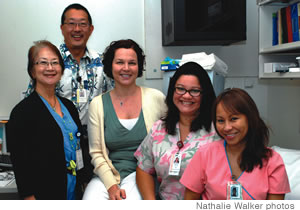
Birth Defects Prevention Month
January 20, 2010
By Dr. Keith Ogasawara


Dr. Keith Ogasawara
Chief of Department of OB/GYN at Kaiser Permanente
Your area of specialty is maternal-fetal medicine. Can you explain what that involves?
A maternal-fetal medicine sub-specialist provides care or consultation for both mother and fetus (unborn baby) in a complicated pregnancy. Maternal-fetal medicine sub-specialists are often involved in medical education and research concerning the most-recent approaches to the diagnosis and treatment of obstetrical problems. He/she thus promotes awareness of the diagnostic and therapeutic techniques for optimal management of these complicated pregnancies.
{embed=“elements/box_ad”}
January is National Birth Defects Prevention Month. Can you discuss what the focus is right now on the prevention of birth defects?
When you talk about prevention, one of the biggest things women can do is speak to their physician before becoming pregnant. Their physician can review their medical history, especially reviewing alcohol, tobacco, physical and chemical agents, prescription and over-the-counter medications a woman may be exposed to. Certain medications can cause birth defects. In fact, it is estimated that 10 percent of all major birth defects are attributable to environmental exposures, and therefore to some extent are preventable. Her physician may also suggest she take supplements like folic acid. Because adequate folic acid intake before and during the first weeks of pregnancy reduces the occurrence of neural tube defects, all women considering pregnancy should consume 400 mcg of folate per day. Depending on her medical history, her physician might even recommend a higher dose.

|
What is the standard right now in screening for birth defects?
The current recommendation is that all women be offered some form of screening for chromosome birth defects. There’s a first-trimester screening that accesses a woman’s risk for Down syndrome and trisomy 18. There also is the second-trimester Quad screen, which screens for Down syndrome, trisomy 18 and also neural tube defects. Women are often offered a second-trimester ultrasound to screen for structural birth defects. One of the things that we emphasize at Kaiser is prenatal diagnosis of congenital heart defects. The reason we do this is there is no neonatal cardiac surgery center in the state. So babies born with a heart defect that requires surgical correction immediately after birth need to be born on the Mainland at one of these centers. Otherwise we would have to transport a baby born here to the Mainland immediately after birth, and that can potentially compromise the baby’s care.
Can you explain the risks of birth defects for women as they get older?
As women get older, their risk for numerical chromo-some defects slowly increases. This is because women are born with a set number of eggs and do not produce new ones during their lifetime. The current theory is the mechanism that helps pull the chromosomes apart during ovulation degrades over time.
{embed=“elements/google_ad336x280”}
Can you talk about preterm labor and how premature baby survival rates have increased?
Advances in neonatology have dramatically improved premature survival rates. In my opinion, the development of surfactant has dramatically changed how I manage preterm labor. Surfactant dramatically improved neonatal outcomes because the respiratory distress syndrome and chronic lung disease that these premature infants had has greatly deceased due to this new therapy. The second big change is the general acceptance of antenatal steroid therapy given to mothers at risk for preterm delivery. This dramatically improves outcomes for infants that are born premature. Finally and most recently, the use of 17 hydroxy progesterone capo-rate for prevention of recurrent preterm delivery. This is the first thing we have that can prevent recurrent preterm delivery in women at high risk for preterm delivery. So that’s a big deal for me.